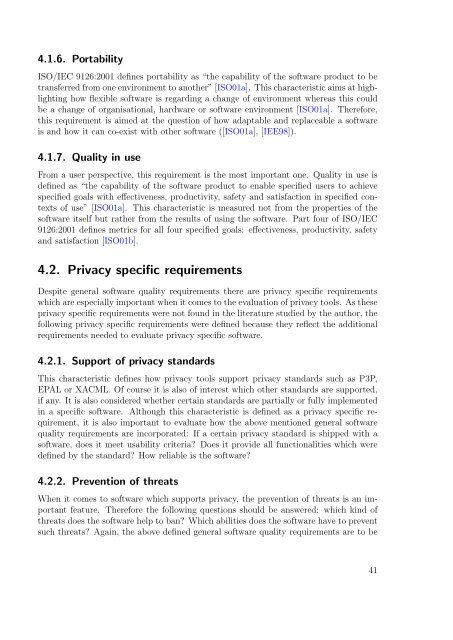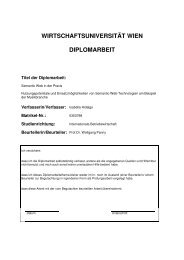Wirtschaftsuniversität Wien Magisterarbeit - SemanticLab
Wirtschaftsuniversität Wien Magisterarbeit - SemanticLab
Wirtschaftsuniversität Wien Magisterarbeit - SemanticLab
You also want an ePaper? Increase the reach of your titles
YUMPU automatically turns print PDFs into web optimized ePapers that Google loves.
4.1.6. Portability<br />
ISO/IEC 9126:2001 defines portability as “the capability of the software product to be<br />
transferred from one environment to another” [ISO01a]. This characteristic aims at highlighting<br />
how flexible software is regarding a change of environment whereas this could<br />
be a change of organisational, hardware or software environment [ISO01a]. Therefore,<br />
this requirement is aimed at the question of how adaptable and replaceable a software<br />
is and how it can co-exist with other software ([ISO01a], [IEE98]).<br />
4.1.7. Quality in use<br />
From a user perspective, this requirement is the most important one. Quality in use is<br />
defined as “the capability of the software product to enable specified users to achieve<br />
specified goals with effectiveness, productivity, safety and satisfaction in specified contexts<br />
of use” [ISO01a]. This characteristic is measured not from the properties of the<br />
software itself but rather from the results of using the software. Part four of ISO/IEC<br />
9126:2001 defines metrics for all four specified goals: effectiveness, productivity, safety<br />
and satisfaction [ISO01b].<br />
4.2. Privacy specific requirements<br />
Despite general software quality requirements there are privacy specific requirements<br />
which are especially important when it comes to the evaluation of privacy tools. As these<br />
privacy specific requirements were not found in the literature studied by the author, the<br />
following privacy specific requirements were defined because they reflect the additional<br />
requirements needed to evaluate privacy specific software.<br />
4.2.1. Support of privacy standards<br />
This characteristic defines how privacy tools support privacy standards such as P3P,<br />
EPAL or XACML. Of course it is also of interest which other standards are supported,<br />
if any. It is also considered whether certain standards are partially or fully implemented<br />
in a specific software. Although this characteristic is defined as a privacy specific requirement,<br />
it is also important to evaluate how the above mentioned general software<br />
quality requirements are incorporated: If a certain privacy standard is shipped with a<br />
software, does it meet usability criteria? Does it provide all functionalities which were<br />
defined by the standard? How reliable is the software?<br />
4.2.2. Prevention of threats<br />
When it comes to software which supports privacy, the prevention of threats is an important<br />
feature. Therefore the following questions should be answered: which kind of<br />
threats does the software help to ban? Which abilities does the software have to prevent<br />
such threats? Again, the above defined general software quality requirements are to be<br />
41





